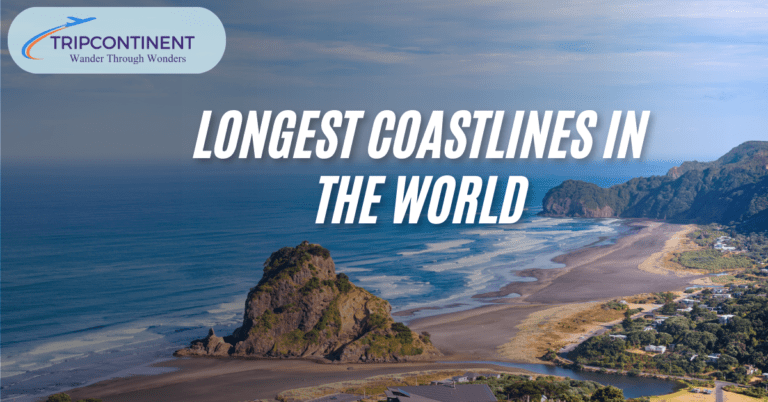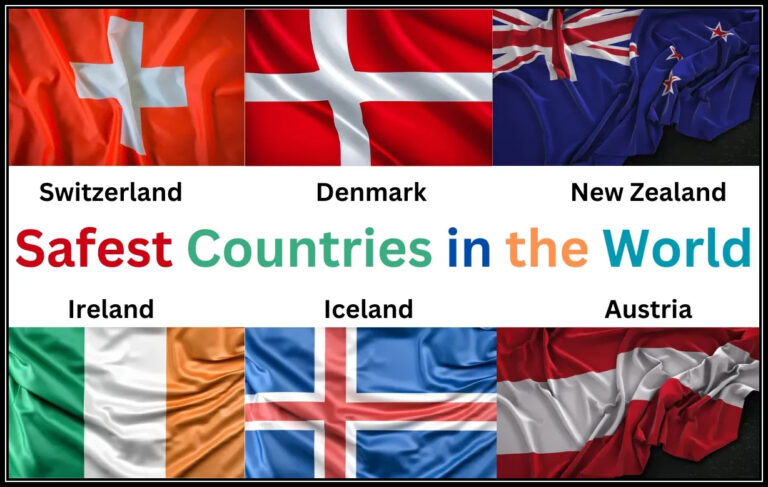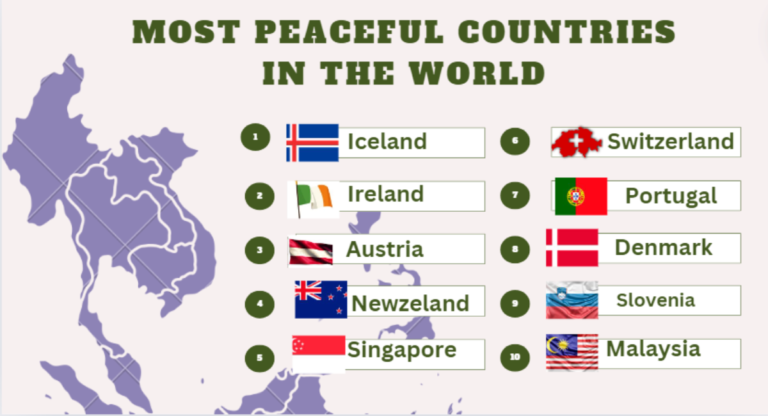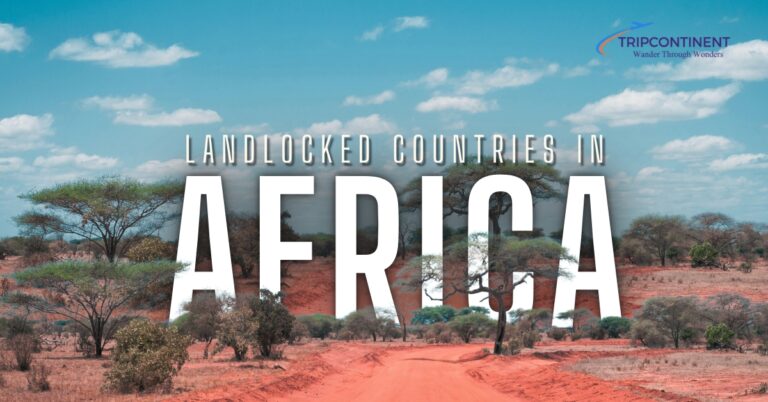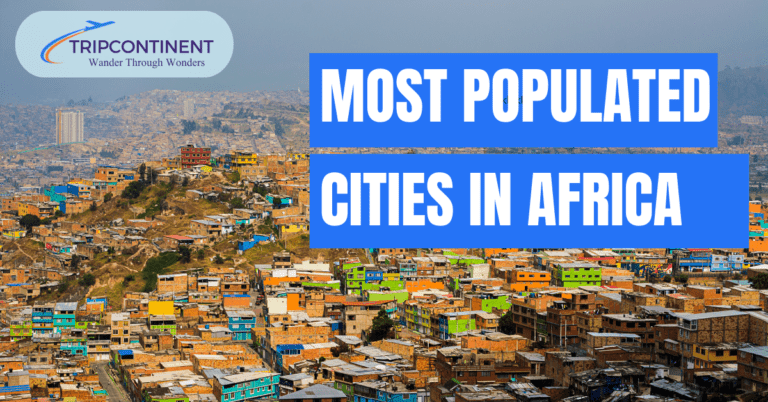Discover the Largest Oceans in the World
The world’s oceans are vast and awe-inspiring, covering approximately 71% of the Earth’s surface. These massive bodies of saltwater are crucial to our planet’s ecosystem, influencing weather patterns, supporting marine life, and providing resources for human activities. Among them, five oceans stand out due to their sheer size and significance: the Pacific, Atlantic, Indian, Southern (or Antarctic), and Arctic Oceans.
These oceans not only define our planet’s geography but also sustain life, drive weather patterns, and facilitate global trade and cultural exchanges, highlighting their immense significance in the natural world.
List of the Largest Oceans in the World
The following is the list of the Largest Oceans in the World.
- The Pacific Ocean
- The Atlantic Ocean
- The Indian Ocean
- The Southern Ocean
- The Arctic Ocean
- Mediterranean Sea
- Caribbean Sea
- South China Sea
- Bering Sea
- Gulf of Mexico
1. The Pacific Ocean
The Pacific Ocean is the undisputed king of oceans, covering a whopping one-third of Earth’s surface! That’s more than all the landmasses put together, stretching a massive 63 million square miles.
This ocean separates Asia and Australia from the Americas. Warm, clear waters lap countless shores, cradling beautiful island chains like Fiji and Hawaii. Divers flock here to explore vibrant coral reefs teeming with colorful fish and fascinating creatures.
But the Pacific isn’t all sunshine and surf. It holds the record for the deepest spot on Earth – the Mariana Trench. Here, the inky blackness plunges over 36,000 feet down. Volcanoes erupt along the edges of the ocean floor, constantly shaping its underwater landscape.
The Pacific plays a vital role in our world. It helps regulate Earth’s climate, provides food for millions of people through fishing, and serves as a major highway for shipping goods between countries. With its diverse marine life, both familiar and strange, the Pacific Ocean remains a place of wonder and discovery.
2. The Atlantic Ocean
The Atlantic Ocean, a vast expanse of deep blue, carves a path between the Americas and Europe/Africa. It’s the second-largest ocean, covering about one-fifth of Earth, roughly 32 million square miles.
Nicknamed the “Sea of Atlas” in ancient myths, the Atlantic has a rich history. For centuries, explorers braved its currents to discover new lands and trade goods. Powerful currents like the Gulf Stream play a big role, carrying warm tropical water up to chilly Europe, and influencing weather patterns worldwide.
The ocean floor holds secrets too. The Mid-Atlantic Ridge, a huge underwater mountain range, runs almost the entire length of the Atlantic.
The Atlantic isn’t just about size and hidden mountains. It’s teeming with life! Whales breach the surface, playful dolphins entertain, and colorful fish dart around coral reefs. On land, sandy beaches and dramatic coastlines beckon visitors for adventure or relaxation.
Also see: Strongest Currencies in the World
3. The Indian Ocean
The Indian Ocean, nestled between Africa, Asia, and Australia, boasts a warm and vibrant personality. While the third-largest at roughly 28 million square miles (think three times the size of the United States), it’s packed with history and life.
Imagine ancient trade routes crisscrossing its waters for centuries, carrying spices, silks, and stories between continents. Today, busy shipping lanes carry goods across the globe.
Sunlight dances on the waves, revealing a treasure trove of marine life. Elegant dolphins leap, while colorful fish flit through vibrant coral reefs teeming with over 200,000 species. On land, swaying palm trees line pristine beaches, perfect for relaxation. The Maldives and Seychelles, with their turquoise waters and coral atolls, are just a glimpse of the paradise this ocean offers.
But the Indian Ocean isn’t just about beauty. Mighty monsoons, powerful seasonal winds, and rains sweep across its surface, shaping weather patterns and nourishing the lands bordering it. Deep trenches, like the Java Trench plunging over 25,000 feet, hold mysteries waiting to be explored.
4. The Southern Ocean
The Southern Ocean, also known as the Antarctic Ocean, is the world’s newest and most unique ocean. Unlike others separated by continents, it encircles Antarctica like a cold, swirling moat. It’s the second-smallest at 7.8 million square miles, but packs a punch.
Formed a mere 30 million years ago when Antarctica drifted apart from South America, it’s the coldest and stormiest ocean. Imagine icy winds whipping across waves that constantly circle the globe, unhindered by landmass. The Southern Ocean holds the title for the windiest and coldest waters on Earth, with average temperatures hovering around freezing (33°F).
This ocean plays a critical role in regulating Earth’s climate. It acts like an air conditioner, absorbing carbon dioxide from the atmosphere and helping regulate global ocean currents.
The Southern Ocean isn’t barren though. Unique marine life thrives in the cold waters. Penguins waddle on icy shores, whales breach the waves, and krill, tiny shrimp-like creatures, form the base of the food chain. The Southern Ocean may be remote and challenging, but it’s an essential part of our blue planet.
5. The Arctic Ocean
The Arctic Ocean, the Earth’s smallest at just 5.4 million square miles, reigns supreme in the chilly north, nestled around the North Pole. Imagine a world covered in sea ice for most of the year, with temperatures averaging a bone-chilling 28°F.
Unlike other oceans, the Arctic Ocean is mostly surrounded by land – countries like Canada, Russia, Alaska (USA), Greenland (Denmark), Iceland, and Norway. Because of the ice, it’s the shallowest ocean with an average depth of just 3,400 feet.
Polar bears stalk the ice floes, while walruses haul out on the shores. Seals and whales navigate the frigid waters, and colorful fish dart beneath the ice. However, climate change is causing the Arctic sea ice to melt at an alarming rate, threatening the delicate balance of this unique ecosystem.
The Arctic Ocean holds a special place in our world. It influences global climate patterns and is a treasure trove of natural resources. As we learn more about this frozen frontier, we can work to protect its wonders for generations to come.
Also Read: Largest Airports in the World
6. Mediterranean Sea
The Mediterranean Sea nestled between Europe, Africa, and Asia, isn’t technically an ocean but a large enclosed sea. At roughly 970,000 square miles, it’s a vital waterway brimming with history and life.
Imagine ancient civilizations like Greece and Rome rising to power along its shores. Today, bustling countries like Italy, Spain, France, and Greece line its coasts, making it a popular tourist destination. Crystal-clear waters lap against sandy beaches, perfect for relaxation.
Underwater, the Mediterranean dazzles with vibrant coral reefs teeming with colorful fish and playful dolphins. Divers flock here to explore shipwrecks and ancient ruins that lie hidden beneath the waves.
The Mediterranean plays a big role in regulating Europe’s climate. Warm currents bring sunshine and mild weather to the surrounding regions. It’s also a key shipping lane, carrying goods between continents.
So, while the Mediterranean may not be a huge ocean, its rich history, vibrant marine life, and beautiful coastline make it a fascinating and important sea on our planet.
7. Caribbean Sea
The Caribbean Sea, a turquoise gem nestled between North and South America, isn’t an ocean but a beautiful sea dotted with over 7,000 islands. Imagine a vast expanse of warm, clear water (averaging around 80°F) lapping at sandy beaches and vibrant coral reefs. This tropical paradise covers about 1 million square miles (think slightly bigger than California and Texas combined).
The Caribbean boasts the second-largest barrier reef in the world, the Mesoamerican Barrier Reef, stretching over 600 miles along Central America. This underwater wonderland shelters a mind-boggling variety of marine life – colorful fish, playful dolphins, majestic sea turtles, and even sharks. Divers and snorkelers flock here to explore this underwater paradise.
The Caribbean isn’t just about stunning scenery. The Cayman Trench, located between Cuba and Jamaica, plunges a staggering 25,000 feet, making it the deepest point in the Caribbean. The region is also home to a unique blend of cultures, influenced by European, African, and indigenous traditions.
This warm sea plays a vital role in the region’s economy. Tourism thrives on the beautiful beaches and crystal-clear waters. Fishing is another important industry, with the Caribbean providing a rich source of seafood.
So, whether you’re seeking relaxation on a beach, exploring vibrant coral reefs, or learning about its rich culture, the Caribbean Sea offers something for everyone.
Also Explore: Most Educated Countries In The World
8. South China Sea
The South China Sea isn’t quite an ocean but a large marginal sea, bordered by mainland Southeast Asia on the west and various island nations to the east. At roughly 1.4 million square miles, it’s a vital waterway brimming with resources and controversy.
Imagine a sea with rich fishing grounds, estimated to supply 12% of the world’s catch. The seabed also holds potential reserves of oil and natural gas, making it an attractive area for many countries.
Here’s where things get complicated. Several countries claim parts of the South China Sea, including China, Vietnam, the Philippines, Malaysia, Brunei, and Taiwan. These claims often overlap, leading to territorial disputes and tensions.
Despite the complexities, the South China Sea is a crucial trade route. Over $5 trillion worth of goods, or one-third of global trade, travels through its waters each year. Busy shipping lanes connect major economies in Asia and beyond.
The South China Sea is also rich in biodiversity. Over 30% of the world’s coral reefs lie within its waters, teeming with marine life. However, pollution, overfishing, and climate change threaten this delicate ecosystem.
9. Bering Sea
The Bering Sea, a northern neighbor of the Pacific Ocean, isn’t technically an ocean but a vast marginal sea. Think of it as an arm of the Pacific Ocean reaching north between Alaska and Russia. Despite its cool waters, the Bering Sea, at about 890,000 square miles (a bit bigger than Texas and California combined), is a hotspot for marine life and a crucial feeding ground.
Imagine a sea where winter temperatures can plunge to a bone-chilling -45°F (-49°C). Sea ice blankets the northern parts for much of the year. This icy characteristic makes the Bering Sea quite shallow, averaging only 160 to 200 feet deep (think a bit taller than the Statue of Liberty).
Here’s the surprising part: this cold sea is bursting with life. Plankton blooms in the spring and summer, feeding massive numbers of fish. Salmon, herring, cod, flounder, and halibut teem in these waters, making the Bering Sea one of the most productive fisheries on Earth.
Mammals find a home here too. Walruses haul out on the shores, while playful seals and majestic whales, like the gray whale and the bowhead whale, migrate to the Bering Sea to feed during the summer months. The islands dotting the sea are breeding grounds for sea otters and fur seals.
The Bering Sea is not just about wildlife. The narrow Bering Strait, a mere 53 miles wide, connects the Bering Sea to the Arctic Ocean and was once a land bridge during the Ice Age, allowing animals and plants to migrate between continents.
The Bering Sea faces challenges too. Climate change and overfishing threaten the delicate balance of this ecosystem. Protecting this cold, yet teeming, sea is crucial for the health of our planet.
10. Gulf of Mexico
The Gulf of Mexico isn’t quite an ocean but a large partially enclosed sea nestled between the southern coast of North America and Mexico. Imagine a bathtub overflowing with warm, salty water (averaging around 80°F). This bathtub is quite big though, stretching over 600,000 square miles.
The Gulf is a shallow sea, with an average depth of only about 5,000 feet. This shallowness makes the water warm and perfect for marine life. Coral reefs thrive in the clear waters, teeming with colorful fish, playful dolphins, and even endangered manatees.
Here’s where things get interesting: the Gulf of Mexico sits on top of oil and natural gas. These resources have made the region an economic powerhouse, but drilling also carries risks of oil spills that can damage the environment.
The Gulf also plays a crucial role in the weather. Warm Gulf waters fuel powerful hurricanes that can bring heavy rain and destructive winds to the surrounding coasts. The Mississippi River, the lifeblood of North America, empties into the Gulf, carrying vital nutrients that nourish the ecosystem.
Fishing is another big industry in the Gulf of Mexico. Shrimp, oysters, and redfish are just a few of the tasty treats harvested from these waters. Tourism also thrives along the beautiful beaches and vibrant coastal towns.
The Gulf of Mexico is a sea of riches and resources, but also vulnerability. Balancing economic needs with environmental protection will be crucial for the future of this warm and vital sea.
A Table Comparison of The Largest Oceans in the World
| Rank | Name | Area (square miles) | Notable Features |
|---|---|---|---|
| 1 | Pacific Ocean | 63 million | Largest ocean, separates Asia and Australia from the Americas, Mariana Trench |
| 2 | Atlantic Ocean | 32 million | Gulf Stream, Mid-Atlantic Ridge |
| 3 | Indian Ocean | 28 million | Ancient trade routes, vibrant coral reefs, monsoons |
| 4 | Southern Ocean | 7.8 million | Encircles Antarctica, coldest and stormiest ocean, regulates Earth’s climate |
| 5 | Arctic Ocean | 5.4 million | Smallest ocean, surrounded by land, polar bears, melting sea ice due to climate change |
| 6 | Mediterranean Sea | 970,000 | Enclosed sea, rich history, vibrant marine life, regulates Europe’s climate |
| 7 | Caribbean Sea | 1 million | Turquoise waters, barrier reef, diverse marine life, popular tourist destination |
| 8 | South China Sea | 1.4 million | Rich fishing grounds, territorial disputes, major trade route |
| 9 | Bering Sea | 890,000 | Productive fisheries, sea ice, migration route, connects to the Arctic Ocean |
| 10 | Gulf of Mexico | 600,000 | Shallow sea, oil and gas reserves, hurricane formation, rich marine life |
Conclusion
In conclusion, the largest oceans in the world are incredibly important to life on Earth.
They regulate climate, support diverse marine life, and provide essential resources for human societies. The vast Pacific Ocean influences weather and climate across the globe, while the historically significant Atlantic Ocean continues to be a crucial route for trade and cultural exchange. The warm waters of the Indian Ocean affect monsoon patterns and connect ancient civilizations. The frigid Southern Ocean supports unique marine life and drives essential ocean currents, and the icy Arctic Ocean impacts global climate and emerging shipping routes.
Understanding and protecting these oceans is vital. They face threats from pollution, overfishing, and climate change, which can disrupt their delicate ecosystems and the services they provide. By learning about these immense bodies of water and recognizing their importance, we can take steps to preserve them for future generations.
FAQs
How Many Seas Are on Earth?
In general, a sea is described as an area of the ocean that is partially enclosed by land. Given that criteria, there are around 50 seas in the world.
What’s the Difference Between Seas and Oceans?
Seas are smaller than oceans and are typically found where land and ocean meet. Typically, seas are partially surrounded by land.
What Is the Most Famous Ocean?
The Pacific Ocean is the most famous. It’s the largest and the deepest.
What Is the Warmest Ocean in the World?
The Indian Ocean is the world’s warmest ocean.
Which Animal Is the King of the Ocean in the World?
The great white shark is widely regarded as the undisputed “king of the ocean.”
What Is the Most Polluted Sea?
The North Pacific is the ocean with the most plastic, followed by the Indian Ocean, the North Atlantic, the South Pacific, the South Atlantic, and the Mediterranean.

I’m Sophia Jones, an adventurer at heart from New York City, USA. I live for travel and exploration, always eager to discover new places, meet fascinating people, and try out diverse cuisines. Over the past few years, I’ve traveled to numerous countries, immersing myself in different cultures and creating unforgettable memories.

